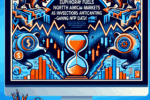New York, NY – Economists are increasingly optimistic about the prospects for robust economic growth this year, as recent retail sales data points to a strong consumer base. The latest quarterly survey by The Wall Street Journal reveals a decrease in the likelihood of a recession within the next year, with experts forecasting a growth rate of 1.4% in the third quarter. This positive outlook is supported by a 0.7% increase in retail sales for the month of March, surpassing expectations and indicating continued consumer spending.
It is important to note that while the recent retail sales data shows strength in consumer spending, there are some noteworthy trends to consider. The period from October to January saw unusually weak retail sales, which may have contributed to the stronger performance in the last two months. Additionally, the March data, while strong, did not match the growth seen in February, which included significant spending periods like Spring Break and Easter.
Furthermore, the retail sales data is not adjusted for inflation, leading to potential misleading conclusions about the state of the economy. When factoring in inflation, the data suggests a more tempered consumer outlook, especially considering the impact of rising oil prices on spending habits. This raises questions about the true strength of the economy when consumers are spending more for the same goods and services.
While nominal retail sales data may indicate a healthy economy on the surface, a deeper analysis reveals potential challenges. An inflation-adjusted view of retail sales shows a weaker consumer landscape, particularly with regard to real household spending power. As interest rates rise, consumer credit supporting retail sales may face increasing strain, potentially impacting the overall growth rate of retail sales data.
In light of these insights, it is crucial to approach economic forecasts with caution and a critical eye. While initial data may paint a positive picture, the long-term trends and underlying factors can provide a more nuanced understanding of the economic landscape. As economists continue to monitor retail sales and consumer behavior, it will be important to consider the broader economic context and potential challenges that may lie ahead.










